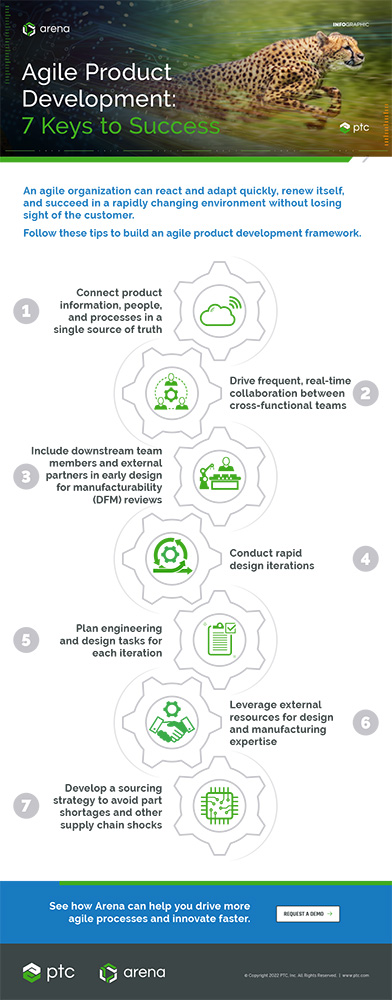7 Tips to Establish an Agile Product Development Framework

It’s not uncommon for manufacturers to encounter one or more of the following scenarios as part of their new product development (NPD) journey.
- Insufficient time to source critical parts for upcoming product release in light of an unforeseen shortage
- Hazardous design flaw is not detected prior to shipment, resulting in a product recall
- Inability to solicit customer feedback throughout the product development cycle
- Limited flexibility to add or change requirements over the course of the project
To avoid these setbacks, many companies are rethinking traditional product development practices and adopting a more agile mindset. Because today’s market is marked by ongoing technological advancements, ever-changing customer demands, evolving regulations, and unforeseen events like pandemics and natural disasters, manufacturers need a systematic way to respond quickly to change and deliver innovative products that give them a competitive advantage.
Agile projects are reported to have a 64% success rate, whereas those utilizing traditional linear Waterfall methods have only a 49% success rate1. Furthermore, companies have experienced an average 60% growth in revenue and profit after implementing agile processes2.
In this article, we explore how agile product development helps drive these improved business outcomes and provide tips for successfully implementing agile practices across your organization.
BENEFITS OF AGILE PRODUCT DEVELOPMENT
Historically, organizations have been accustomed to using a linear product development process known as Waterfall. Based on a series of sequential steps, this methodology prohibits teams from proceeding to the next phase until the previous one is completed. Different individuals are assigned to specific tasks with minimal cross-functional collaboration. Moreover, product requirements are defined and pretty much set in stone at the beginning of the project. This leaves little room for changes in the event of sudden market shifts.
Unlike the Waterfall approach which limits visibility and flexibility, agile product development focuses on frequent communication, rapid design iterations, and constant refinement. The goal is to design and produce products that truly resonate with customers and reflect the current market.
Agile vs. Waterfall Methodology
| Agile | Waterfall | |
| Frequent cross-team collaboration | ||
| Flexibility to change requirements and experiment with different ideas | ||
| Short, iterative design cycles | ||
| Client involvement at every stage of product development | ||
| Project timeline is mapped out and fixed from start to finish | ||
| Teams must complete work in linear, sequential steps; inability to work simultaneously on different phases |
Key advantages of agile product development:
Increases customer satisfaction
From the concept phase and beyond, manufacturers keep customers in the loop and involve them in decisions surrounding the product design. End users can interact with early prototypes and provide input on physical characteristics and functionality. This helps companies deliver greater value and ensure that the final product is built according to customers’ unique requirements. Ultimately, they foster loyalty that results in long-lasting customer relationships.
Enhances visibility and minimizes risks
Frequent communication between internal teams and external supply chain partners ensures that everyone always has complete visibility into design errors, part shortages, production delays, compliance issues, and other bottlenecks that could negatively impact product releases. Organizations are then more proactive at implementing the appropriate countermeasures to mitigate risks.
Helps teams manage changing priorities
Since teams are constantly testing out new requirements or fine-tuning existing ones with each iteration, they can quickly change course in the event of a new customer finding or business initiative. Because tasks are completed in short iterative cycles, the amount of rework or replanning that needs to be done is minimized.
Accelerates product releases
With a collaborative foundation in place, agile teams stay aligned and focused on working toward a common goal. They perform multiple tasks in parallel and establish a steady and efficient pace to expedite the NPD cycle.
PUTTING AGILE INTO ACTION: 7 KEYS TO SUCCESS
To establish a more agile operation and help drive greater efficiencies and visibility throughout your NPD process, follow these tips:
- Implement a proven cloud-native solution that connects your people, processes, and product information in a single source of truth.
Cloud-native product lifecycle management (PLM) and quality management system (QMS) solutions enable dispersed teams to access the latest designs and collaborate in real time on requirements, component sourcing, production planning, regulatory audits, and other critical NPD activities. Quality information automatically links to the product record, enabling teams to have complete visibility and traceability into product nonconformities throughout the entire lifecycle and streamline compliance. Access to business analytics also gives teams greater insights into product development processes and helps them identify opportunities for future improvements. - Drive frequent, real-time collaboration between cross-functional teams
Having a cloud-native PLM or QMS solution in place makes it easy for individuals from engineering, quality, operations, procurement, supply chain/contract manufacturing, and other key functions to work together and continually refine the product. Regular communication empowers team members to contribute new ideas that help drive innovation. - Include key stakeholders in early design for manufacturability (DFM) reviews
Getting key stakeholders to conduct DFM reviews early on and throughout the product lifecycle is critical to ensuring that you meet your quality and cost targets. Cloud-native PLM and QMS solutions with a seamless connection to CAD enable engineers to quickly disseminate updated designs to downstream product team members and external partners. In turn, they can lend their feedback to help mitigate production issues that lead to costly scrap and rework. - Conduct rapid design iterations
Through rapid iterative cycles or sprints, teams make small, incremental design changes and release them to customers and other key stakeholders for evaluation. The cycle is repeated, and adjustments are continually made until the desired outcome is reached. This iterative approach enables you to refine and update the design quickly while ensuring that the final product meets customer expectations. - Plan engineering and design tasks for each iteration
Develop a prioritized list of engineering and design tasks (i.e., product backlog) for each iteration to ensure everyone is aligned on key objectives. By linking project deliverables directly to the product record, cloud-native PLM and QMS solutions enable your teams to efficiently execute product work and deliver the next release. - Leverage external resources for design and manufacturing expertise
Establishing partnerships with contract manufacturers (CMs), designers, and other external resources gives you access to the specialized facilities, equipment, and expertise that are needed to accelerate time to market and further differentiate your products. With secure, user-based access to a cloud-native PLM or QMS solution, external partners can quickly and easily exchange information with your internal team members and stay actively involved in the design process. - Develop sourcing strategy to help mitigate supply chain risks
Having multiple suppliers across different geographical regions enables you to secure substitute parts when faced with shortages. In addition, choosing suppliers that are near to your production site helps you avoid logistics issues stemming from political unrest and other regional crises. By leveraging a cloud-native PLM or QMS solution, your teams have centralized access to approved supplier/vendor lists (ASLs/AVLs) and electronic component databases to efficiently manage and track parts availability and get products built on schedule.
Agile Product Development: 7 Keys to Success
View Infographic
CONCLUSION
If you are having to regularly change course in response to volatile market conditions, then agile product development is well suited for your organization. By adopting a cloud-native PLM or QMS solution, you can quickly establish an agile framework to streamline NPD and get innovative products to market faster.

A NEW ERA OF PRODUCT DEVELOPMENT
To minimize risks and achieve commercialization success, organizations must rethink traditional product development practices and embrace more modern approaches. This is especially critical in today’s global economy, as companies now deal with increased competition, evolving regulatory requirements, supply chain disruptions, and a shift to a virtual workforce.
In this ebook, we explore how cloud-native solutions provide manufacturers a more agile framework to efficiently execute product work and accelerate innovation.
References
1. Sweeney, M. Agile vs Waterfall: Which Method is More Successful? 2022.
2. Flynn, J. 16 Amazing Agile Statistics (2022): What Companies Use Agile Methodologies. 2022.



